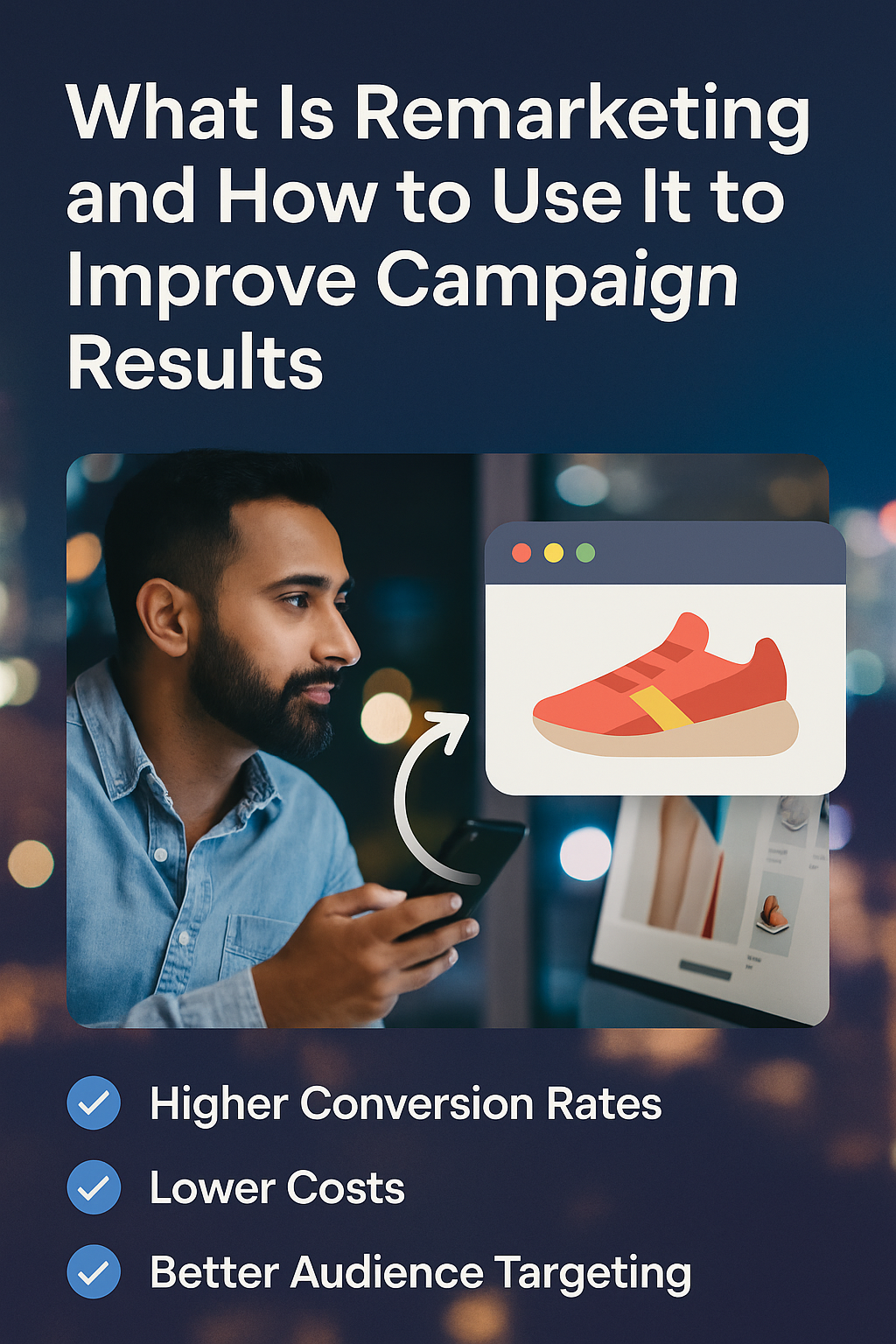Have you ever visited a website, browsed a product, and then started seeing ads for that same product everywhere — on Facebook, Instagram, YouTube, or other sites?
That’s not magic. That’s remarketing — one of the most powerful and profitable strategies in digital marketing.
If you’re working as a traffic manager or aspiring to become one, learning how to implement and optimize remarketing campaigns is a game changer for your results.
In this article, we’ll explain exactly what remarketing is, how it works, and how to use it strategically to boost conversions, lower costs, and increase return on ad spend (ROAS).
What Is Remarketing?
Remarketing (also called retargeting) is the practice of showing ads to people who have previously interacted with your business in some way — but didn’t convert.
This can include people who:
- Visited your website
- Viewed a product or service
- Added items to their cart
- Started a form but didn’t submit
- Engaged with your social media or video content
The goal is to re-engage warm audiences — those who already know your brand — and bring them back to complete the action.
How Remarketing Works
Here’s the basic process:
- A user visits your website or interacts with your ad
- A tracking pixel or tag records the behavior
- That data is saved in a custom audience list
- You create ads specifically for that audience
- Those ads are shown across platforms like Facebook, Instagram, YouTube, or Google Display
Since these users already know your brand, they are more likely to convert than cold audiences — often at a lower cost per result.
Platforms That Support Remarketing
✅ Facebook & Instagram (Meta Ads)
Use the Meta Pixel to track:
- Website visitors
- People who viewed specific products
- Users who interacted with your page, Instagram profile, or videos
You can then run:
- Dynamic product ads
- Lead form reminders
- Discount or urgency-based ads
✅ Google Ads
Google’s remarketing works across:
- Search
- Display Network
- YouTube
- Gmail
You can create audience segments based on:
- Website behavior
- App usage
- YouTube channel interactions
- CRM uploads (email lists)
✅ TikTok, LinkedIn, Pinterest
These platforms also support remarketing through their own pixel or tag.
Benefits of Remarketing
Here’s why every traffic manager should use it:
🔥 Higher Conversion Rates
Warm audiences are more likely to take action because they’re already familiar with your offer.
💰 Lower Costs
Since remarketing focuses on users further down the funnel, cost per acquisition (CPA) tends to be lower.
⏳ Extended Sales Cycle Coverage
Not everyone buys right away. Remarketing lets you stay top-of-mind during the decision-making process.
🎯 Better Audience Targeting
You’re not guessing — you’re reaching people who already showed interest.
Types of Remarketing Campaigns That Work
1. Cart Abandonment
Target users who added items to their cart but didn’t check out.
Ad message:
“Still thinking about it? Your cart is waiting — complete your order now and get 10% off.”
2. Lead Form Reminders
People who opened but didn’t submit a lead form.
Ad message:
“You were almost there! Sign up now to reserve your spot.”
3. Content Viewers
People who visited a blog post or watched a video.
Ad message:
“Loved our video on productivity? Take the next step and download our free guide.”
4. Time-Based Remarketing
Show ads to people after a set number of days.
- Day 1–3: Warm-up ad
- Day 4–7: Social proof or testimonials
- Day 8–14: Scarcity offer (limited time, last chance)
How to Set Up a Remarketing Campaign (Example: Meta Ads)
Step 1: Install the Pixel
Use Meta Pixel and verify it’s firing correctly using the Meta Pixel Helper extension.
Step 2: Create a Custom Audience
Go to Audiences > Create Audience > Custom Audience, then select:
- Website Traffic
- Facebook Page Engagement
- Instagram Profile Engagement
- Video Views
- Lead Forms Opened or Completed
Step 3: Create the Ad Campaign
- Objective: Use Conversions or Sales
- Ad Set: Choose your custom audience
- Ad Creative: Tailor the message for returning users
Step 4: Add Exclusions
Exclude people who already converted — unless you’re doing upsell or cross-sell ads.
Tips to Make Your Remarketing Campaigns More Effective
- Segment your audience: Don’t treat all website visitors the same. Different actions require different messages.
- Keep the frequency under control: Don’t overwhelm users. Set frequency caps to avoid ad fatigue.
- Use dynamic ads for e-commerce: Show the exact product a user viewed, directly in the ad.
- Incorporate urgency and scarcity: Use phrases like “Only 24 hours left” or “Limited stock available.”
- A/B test your creatives: Try multiple versions to see what converts best.
Remarketing vs. Retargeting: What’s the Difference?
Though often used interchangeably:
- Remarketing typically refers to email-based follow-ups (e.g., abandoned cart emails)
- Retargeting usually refers to ad-based campaigns via pixels
But in most contexts, both terms refer to bringing people back into your funnel.
Final Thoughts: Don’t Let Warm Leads Go Cold
As a traffic manager, your job is not only to attract new users — it’s to make the most of every visitor.
Remarketing lets you recover lost leads, boost conversions, and build brand loyalty by staying visible to the right people at the right time.
Start using it from your very first campaign — and you’ll instantly be ahead of most beginners in the game.
